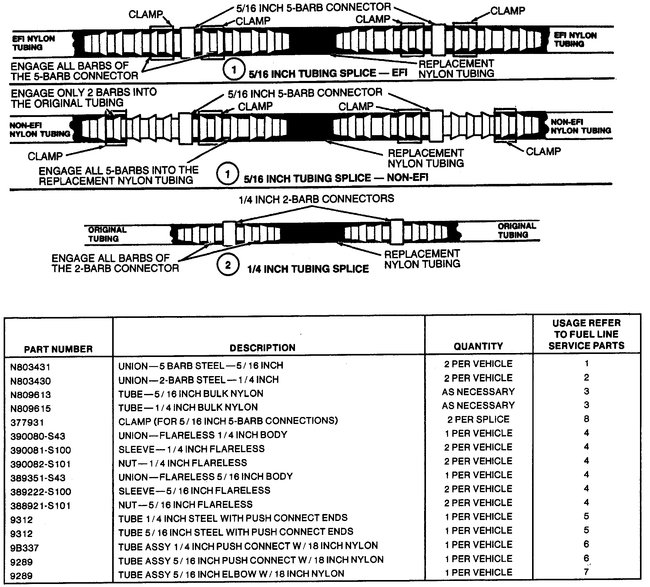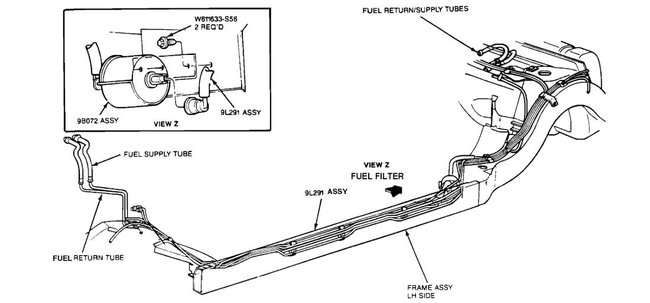Welcome to 2CarPros.
Here are the directions for repairing the nylon fuel line. The attached picture correlates with the directions and show how the connections are made.
_________________________
1. Relieve fuel system pressure. If necessary, drain fuel tank.
2. Cut out damaged section of tubing and retain as a guide.
3. Cut a section of service tubing (type 11 or 12 nylon available in 1/4 and 5/16-inch sizes) to the same length as the damaged section of tubing.
NOTE: To make hand-insertion of the barbed connectors into the nylon easier, the tube end must be soaked in a cup of boiling water for one minute immediately before pushing the barbs into the nylon.
CAUTION: Do not use any heating method except hot water to repair nylon tubing. Temperatures above 100°C (212°F) cause the nylon to soften and will not seal on the barbed connectors. Replacing nylon line in the engine compartment requires heat protective Hypalon hose.
4. Select the proper (1/4 or 5/16-inch) barbed connectors for completing the splice. Two connectors are required for each splice.
5. Install the barbed connectors into each end of the replacement tubing using boiling water.
6. Install clips onto any tubes which might be difficult to access once the final splices are completed.
7. Install four keystone clamps loosely onto the original nylon tubing before beginning Step 8.
8. Complete the splice of the replacement nylon to the original nylon tubing at both ends. Refer to the illustration.
9. Tighten the clamps in the locations shown in the illustration.
10. Install any remaining clips which were removed for service and check that the tubes are secured in the original clips.
11. Fill fuel tank, start engine and check for leaks.
_____________________________
As far as the fuel filter, you can remove those connections and reuse them. There is an O-ring in there, so make sure it isn't damaged.
Here are the directions for the fuel filter. Pic 2 shows the filter, and all lines on the frame.
REMOVAL
1. With engine OFF, relieve the fuel system pressure, refer to Service and Repair / Fuel Pressure Relief Procedure.
2. Raise the vehicle on a hoist.
3. Remove the push connect fittings from both ends of the filter.
4. Remove the fuel filter and retainer from the metal bracket by removing the two retaining bolts.
5. Remove the filter from the retainer. Note the direction of the flow arrow.
6. Remove the rubber insulator rings from the filter.
INSTALLATION
1. Install the rubber insulator rings on the new filter. If the filter moves freely in the retainer, replace the insulator rings.
2. Place the filter in the retainer with the arrow pointing out of the open end of the retainer.
3. Install the fuel filter retainer on the metal bracket and tighten the bolts to 3-5 Nm (27-44 lb in).
4. Install the push connect fittings onto the filter ends.
5. Cycle ignition switch from OFF to RUN position several times, without starting engine. Check for fuel leaks.
6. Lower vehicle.
+++++++++++++++++++++++++++++
Let me know if this helps.
Take care,
Joe
Images (Click to make bigger)
SPONSORED LINKS
Saturday, August 10th, 2019 AT 8:50 PM


